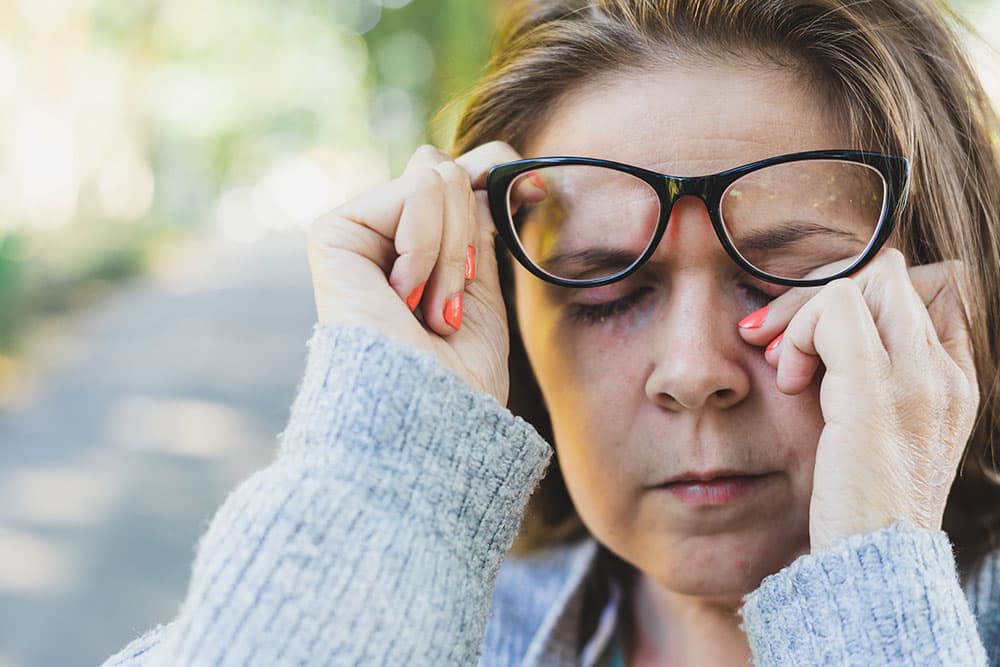
The most common symptoms of ocular allergy include itching, redness of the eyes and eyelids, watering, and swelling of the eyes and eyelids. Other less common symptoms are a scratchy, gritty feeling when blinking, increased sensitivity to light (photophobia), and blurred or hazy vision. Of these symptoms, itching is the most common. Many of the other symptoms are the same as and can easily be confused with, Dry Eye Syndrome and should be carefully evaluated.
Allergy season begins to peak as the temperature begins to increase. When allergy season arrives, it brings increased levels of airborne pollen from trees and grasses. For some particularly sensitive individuals, the allergy “season” can last all throughout the year.
How common are allergy issues? It has been estimated that 20% of the U.S. population, nearly 50 million people, suffer from some sort of allergy. Of these, 60% have some eye-related symptoms. An allergic response is an unwarranted overreaction of the body’s immune system to foreign substances known as allergens. Allergens are wrongly perceived by the body as a threat. A multitude of allergens can trigger an allergic response. These include seasonal culprits such as pollens and grasses, or can be year-long agents such as dust, animal dander, and mold.
Allergies are more common in children than in adults. These allergens can be found anywhere, from your rugs, carpeting, and bedding to your child’s toys and clothes.
Nasal symptoms such as sneezing, sniffing, and a stuffy nose, as well as a dry cough, will frequently occur at the same time as eye symptoms. Medical treatment such as prescription oral antihistamines can offer some relief to ocular symptoms, but are far less effective than prescription strength eye drops in controlling the itching and swelling of the eyes.
Some treatments for allergies may cause dry eye symptoms.
Here are a few tips for helping control your allergies:
Despite these efforts, ocular symptoms may need treatment. Prescription allergy drops have been found to be safe and effective in children as young as three years old as well as adults.

Before beginning any treatment option, it is advisable to first know what triggers an allergic episode. This is done through allergy testing. To determine the cause of your allergies. We will review your medical history, check your lungs, and apply a short, pain-free skin test that will reveal the source of your allergies in just 15 minutes. This test, the gold-standard of allergy diagnosis, is essential to not only determine the exact cause of your allergies, but helps determine the best treatment plan for you.
When patients have a history of allergies, it is not uncommon for contact lens wear to make the allergy problem worse. The contact lenses in the eyes act like little sponges, soaking up environmental allergens, thus increasing the exposure time of the eyes to these irritating substances.
In addition to the common environmental allergies such as pollen and dust, contact lens wearers can also develop allergies to protein and other deposits on the contact lenses, the contact lens material itself, or to the contact lens care products used such as cleaners and re-wetting drops.
Fortunately there are several treatments that can be used to lessen the allergy symptoms associated with contact lens wear. Switching to daily disposable contact lenses, that is, lenses that are worn for one day and then thrown away, can be better for some people with allergies because the problem of allergen build-up on the lens surface is less.
Also, the daily disposal of the lenses eliminates the use of lens cleaners and disinfecting solutions, minimizing the risk of developing an allergy to these products.
Using prescription eye drops can also make contact lens wear more comfortable during allergy season. These drops can be safely used before and after daily contact lens wear.
We offer LASIK and implantable contact lenses as another option for your vision correction which would help to eliminate an allergic reaction to lens care products. We also have many new advances in spherical astigmatism correction and multifocal lens design.
There is good news for allergy sufferers: prescription eye drops are available which can provide relief from the itching, redness, swelling, and watering. Although non-prescription drops may temporarily relieve some of these symptoms, after three or four hours their effect tends to wear off. Also, frequent use of non-prescription drops which are marketed as “getting the red out,” can actually cause an increase in redness of the eyes in some people. This is called a “rebound effect” and is why over-the-counter allergy eye drops usually contain, a warning to not use the product for longer than a few days. They can also contribute to dry eye syndrome.
Over-the-counter eye drops such as Pataday®, and Zaditor® relieve symptoms, and can safely be used for as long as needed. These medications are usually used once or twice a day. Contact lens wearers can also safely use them, as long as they wait approximately ten minutes after the morning drop to insert their contacts, and remove the contacts before instilling the evening drop. These allergy drops may also be helpful in preventing allergic irritation if used early in the spring season before symptoms begin.
It is common for allergy sufferers to take oral (by mouth) antihistamines to relieve their symptoms. Although these drugs can lessen the systemic symptoms such as nasal congestion, itchy throat, and post-nasal drip, they can also have undesirable side effects on the eyes, which include dry eye symptoms.
These medicines can cause significant ocular drying. The reduction in tears not only causes an increase in burning and irritation of the eyes, but it may also diminish the eyes’ ability to flush out the allergens from the surface of the eye causing the allergic reaction to increase.
In this respect, oral antihistamines may sometimes actually make the eyes more irritated and itchy rather than better. Patients who need to take oral antihistamines should consider also using artificial tears to help wash out allergens. Refrigerating the artificial tears can add to the soothing effect of these products.
Preservative-free artificial tears are typically less irritating to sensitive, irritated eyes. Some people are allergic to the preservatives present in many eye drops.
Wearing glasses, sunglasses, or protective eyewear that fits close to the face, is designed to “wrap” around the face, or has side shields that can slow the evaporation of tears from the eye’s surface. Special sun and protective eyewear are made with a soft, flexible, removal facial cavity seal that blocks wind, debris, allergens, and peripheral light. Top-down ventilation keeps your eyes cool and lenses fog-free. It provides special protection for people with dry eyes and allergies. See our optical center for these special features or view the “climate control” section at www.WileyX.com.
Need help? Reach out to us today at 239-542-2020.
The material contained on this site is for informational purposes only and is not intended to be a substitute for professional medical advice, diagnosis, or treatment.
Always seek the advice of your physician or the other qualified health care provider.